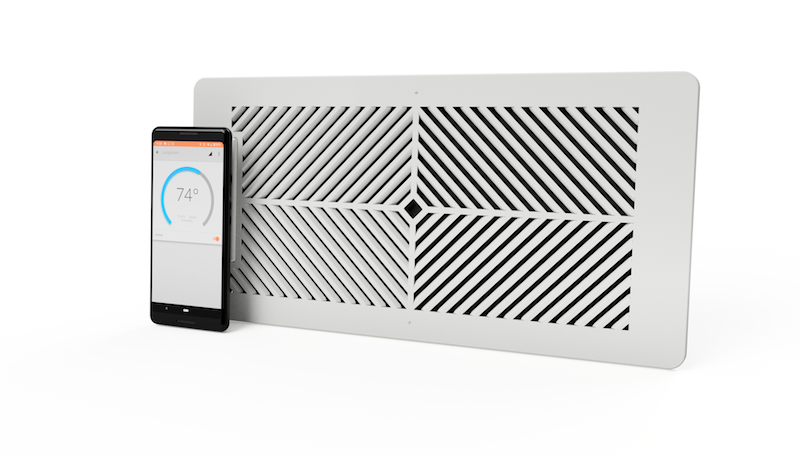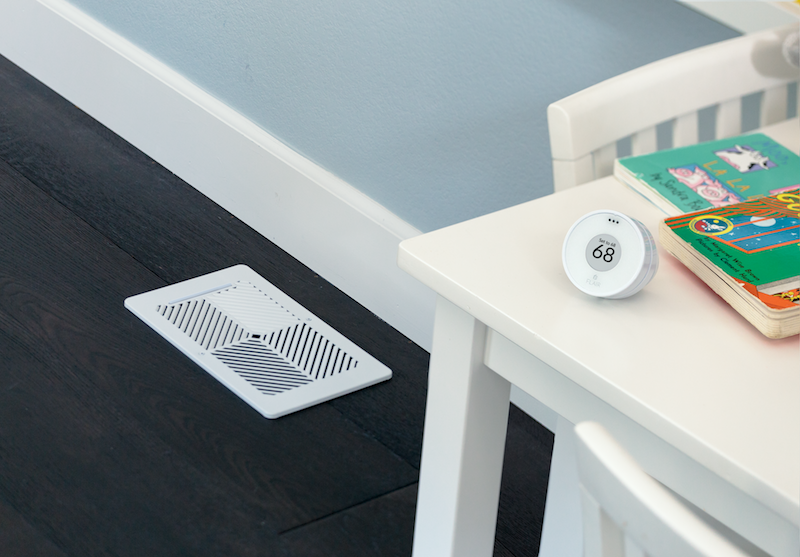The Flair Smart Vent system consist of Motorized Smart Vents that replace existing floor-, wall-, and ceiling-mounted HVAC registers in a home.
Ideally, every room in a home will be the same temperature when the central heating or air conditioning system is running. Unfortunately, this is not always the case. During the winter a north-facing room can be much colder than a south-facing room with several windows that let the sun in. Similarly, that same south-facing room will be much warmer in the summer than a north-facing room that is shielded from the sun.
Closing window coverings to block the warming rays of the sun from coming into a room may help to better equalize the temperature in different rooms of a home. However, the underlying issue is that the airflow from the heating, venting, and air conditioning (HVAC) system isn’t balanced properly to evenly heat/cool all the rooms in the home.
According to the website Contracting Business, fixing an airflow imbalance in an HVAC system can be difficult and depends on the cause of the problem. “Common difficulties include poor design and installation practices, undersized ducting, restrictive fittings, tight installation conditions, and overly restrictive filters,” the website notes. Needless to say, surgical changes to the ducts that run behind walls, within ceilings, and under floors in a home can be messy and expensive.
Flair Smart Vents offer an affordable way to fix an airflow imbalance. They also include additional features that take them beyond the role of a simple HVAC problem solver.
Flair’s Smart Vent system consist of Motorized Smart Vents that simply replace the existing floor-, wall-, and ceiling-mounted HVAC registers in a home. The vents also include Flair Pucks that act as both thermostats regulating the operation of the Smart Vents and control points.
If you have rooms that receive too much air from your HVAC system and are either too cold in the summer or too warm in the winter, then you can place Flair Smart Vents in these rooms and they will restrict the air being sent to them to balance the temperature between these rooms and the rest of your home.

Similarly, if you have rooms that are too cold in the winter or too warm in the summer because there isn’t enough airflow to these rooms from your HVAC system, then you can purchase Flair Smart Vents for the other rooms in your home. The Flair Smart Vents will again balance the amount of air being sent to the rooms in your home for even heating and cooling.
In addition, Flair can also provide you with the ability to specify different temperatures in different rooms as if you had a multi-zone HVAC system.
The Flair Comfort Calculator on the company’s website can assist a homeowner in designing a system that fits the specific requirements of a home. Flair also offers the ability to schedule a 15-minute consultation with a home comfort advisor to discuss the issues in your home and design a system that meets your needs.
The Flair Smart Vents feature metal construction and can be either battery operated or wired using a 24 VAC power supply. Under normal use the two C batteries (included with each Smart Vent) will last approximately three to four years. The system will also monitor battery life and send the homeowner notifications when the batteries need to be replaced.

The Flair Smart Vents are available in a variety of sizes that should fit the HVAC vents in most homes. They are shipped in white but can be painted to match a home’s décor. Be aware, however, that painting the vent voids Flair’s 60-day return policy.
Flair Pucks act as the sensors and controllers in the system. The first Flair Puck that you set up will act as a Wi-Fi gateway for your other Flair devices, your home Wi-Fi network, and the Flair cloud (Flair devices communicate with each other using 915 MHz radios). All other Flair Pucks are room sensors that provide temperature information to the system and control points that allow a user to adjust the desired temperature in a room.
The Flair Gateway Puck must be powered using a USB power supply, while all other Flair Pucks in a home can either be powered by a USB power supply or by two AAA batteries. Under normal use the batteries will last one year.
In addition, the Flair system supports:
- Geofencing –The system will automatically switch between home and away temperature settings
- Room Occupancy Sensing – The optimize the temperature in a room when used with a compatible Honeywell thermostat and Honeywell room occupancy sensors.
It is also important to know that Flair is not limited to supporting just a forced-air HVAC system with a thermostat and vents. A Flair Puck includes an IR blaster and can send commands to control a Mini-Split HVAC system, portable heater or air conditioner, and a window air conditioner, as long as these devices can be controlled by a hand-held, remote control.
Flair Pucks also include a small E-ink display, and the Puck can be rotated and pressed to, for example, adjust the desired temperature for the room where the device is located.
The Flair app is available for iOS, Android, and web app for laptops and other devices. It is very full featured and easy to use. Through the app you can set up schedules, adjust the temperature in any room with a Flair Smart Vent or, where a Flair Puck is being used to control a heating/cooling system through IR, manage the system configuration/settings and more. Flair claims that a homeowner can save up to 30% on the cost of heating/cooling their home using the Flair Smart Vent system.
Flair offers built-in integration with Google Nest, Ecobee, Honeywell Home, Honeywell Total Connect Comfort, Carrier, Bryant, and GE Appliances/Haier. The system can also leverage Ecobee and Honeywell remote sensors as room temperature sensors to save on the number of Flair Pucks that you need to purchase. Through Amazon Alexa, you can use voice commands to set the temperature in either the whole house or an individual room. In addition, you can use a voice command to check the temperature in any room. With Google Assistant, you can use voice commands to check or set the temperature in any room and also turn off a room.
In addition, Flair has a published API that has allowed their Smart Vents and Pucks to be integrated with a selection of the third-party smart home platforms including:
- SmartThings – Using this community written driver available on GitHub
- Hubitat – Using the driver written by Maisons Eco-MatiQ
- Home Assistant – I found several community written drivers available for Home Assistant. Here is one and here is a second one
For my testing I used a Hubitat Elevation hub running the Maison’s Eco-MatiQ driver as a gateway to link the two Flair Smart Vents and two Flair Pucks to a Crestron smart home system with the Crestron-Hubitat integration driver that is available for download from my GitHub. Given that the Flair API requires full OAUTH 2.0 authentication, this was much more expedient than writing a full Crestron-Flair driver myself. I simply needed to extend my Crestron-Hubitat driver to include the Flair.
The Maison’s Eco-MatiQ Flair driver for the Hubitat is full featured and inexpensive to purchase.
Flair provided me with a simple two-room system of Flair Smart Vents and Pucks for testing for this article. Setup of the Flair Smart Vent system is relatively simple, especially given all the functionality that Flair has incorporated into their product. Flair offers a selection of videos on YouTube to help with the process.
The Flair app walks you through the process of setting up a home, connecting the Flair Gateway Puck to your homes 2.4 GHz Wi-Fi network and the rest of the steps necessary to configure your system.
Some of the options that you can choose in setup are:
- Auto vs Manual Mode – Whether the Flair system will automatically adjust your Smart Vents, or Mini-Split system, to optimize the temperature across the rooms in your home, or whether you want to manually control the Smart Vents yourself
- Smart Away vs Off Only – Whether the Flair system will balance energy saving while preventing your home from getting too hot/cold when the home is unoccupied, or whether it will simply close the Flair Smart Vents to cutoff air flow to rooms when the home is unoccupied
- Geofencing – Whether the system will automatically detect occupancy of the home, or whether you will manually set the system from home to away mode using the Flair app
Again, I found the Flair app to be very well designed and easy to use. Too often you make decisions during the initial setup of a product and later, as you learn more, you want to change something. Some products make this process very painful. I found it very nice that Flair didn’t lock you into any of the decisions you made during the initial setup.
Flair also did a very good job of balancing the temperature in rooms where Flair Smart Vents are installed. And, while you can’t do this in too many rooms of your home, I could even shut off the heating/cooling of our guest bedroom when it wasn’t being used.
The integration of the Flair System with my Crestron controlled home also worked well and added real value. For example, I am not a big fan of using geofencing to determine the occupancy of a home. The more people that live in a home the higher the chances are for errors. Instead, I prefer to use a security system to determine occupancy of our home. When the security system is armed in away mode you can be absolutely sure that nobody is home.
The security system is integrated with our Crestron smart home system. Through the integration of the Hubitat Elevation hub, I used the armed/disarm state of the security system to trigger the home/away status of the Flair system.
In addition, I setup Alexa routines to allow me to trigger whether we had a guest staying over or the guest room was unoccupied.
I really found nothing to dislike about the Flair Smart Vent system. My one wish is that the Flair Puck would work better on a tabletop. If a Flair Puck is securely mounted on a wall, then it is easy to twist/press it to operate the user interface. On a tabletop this becomes an awkward two-handed operation as the included plastic stand, and light weight of the Puck, won’t hold it in place while you operate it. A better stand that is weighted and includes a non-slip rubber bottom would work much better.
Overall, I found the Flair Smart Vent system to be a well-designed product. It is easy to install, easy to use, does a good job of balancing the temperature across the rooms in the house where it is installed, and includes a wealth of added features.
It isn’t an inexpensive product, at just over $200 per room for a Flair Smart Vent and Puck. But there may be rebates and incentives available, depending on where you live, that can offset a little of that cost. However, you need to keep in mind that in addition to making your home more comfortable, according to Flair, it can save up to 30% on the cost of heating / cooling your home.





![integrateu header [Photo credit | IntegrateU]](https://restechtoday.com/wp-content/uploads/2025/05/integrateu-header.jpg)


